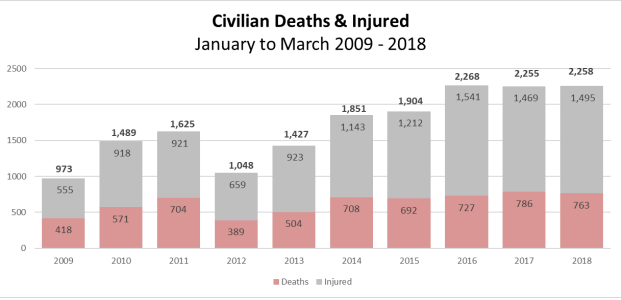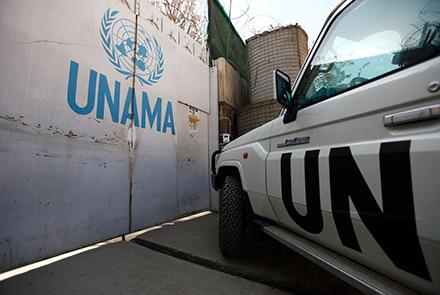The UN Assistance Mission in Afghanistan (UNAMA) on Thursday reported that during the first three months of 2018, anti-government elements caused 1,500 civilian casualties - a six percent increase from the same period last year.
Consistent with trends observed in 2017, the report noted that civilian casualties attributed to pro-government forces in the first quarter of 2018 reduced by 13 percent to 407 civilian casualties.
As such, UNAMA renewed its call on all parties to the conflict to increase efforts to protect civilians, as the number of civilians killed and injured by armed conflict in the first quarter of 2018 remained at the same high level recorded in 2017.
In its quarterly report, issued on Thursday, for the period 1 January to 31 March 2018, UNAMA documented 2,258 civilian casualties (763 deaths and 1,495 injured), reflecting similar levels of civilian harm documented in the first three months of 2017 and 2016.
“All parties to the conflict in Afghanistan must do everything in their power to protect civilians from harm,” said Ingrid Hayden, the Secretary-General’s Deputy Special Representative for Afghanistan.
“Afghan civilians continue to suffer, caught in the conflict, in ways that are preventable; this must stop now,” she said.
The quarterly report describes civilian casualties from suicide improvised explosive devices (IED) and complex attacks as the leading cause of civilian casualties, a new trend observed in 2018.
UNAMA found that ground engagements were the second leading cause of civilian casualties, followed by targeted and deliberate killings, explosive remnants of war, and aerial operations.
Additionally, the report notes with concern that the number of civilian casualties attributed to anti-government elements increased.
During the first three months of 2018, according to the report, anti-government elements caused 1,500 civilian casualties (511 deaths and 989 injured) a six percent increase from the same period last year.
Consistent with trends observed in 2017, civilian casualties attributed to pro-government forces in the first quarter of 2018 reduced by 13 percent to 407 civilian casualties (176 deaths and 231 injured).

The mission found that pro-government forces caused 18 percent of all civilian casualties in the first three months of 2018 (11 percent by Afghan national security forces, two percent by international military forces, four percent by undetermined pro-government forces, and one percent by pro-government armed groups).
During the first three months of 2018, the mission documented 142 civilian casualties (67 deaths and 75 injured) from aerial attacks, similar to the number documented during the same period in 2017. The mission attributed 35 percent of civilian casualties from air strikes to international military forces, 35 percent to the Afghan Air Force, and the remainder to unidentified pro-government forces.
CLICK HERE for the full report.


